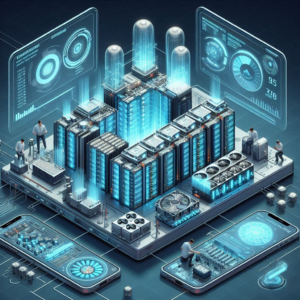Performance Metrics for Engineering Efficiency

Introduction to Hardware Systems Performance
In modern engineering, hardware system performance is crucial for ensuring efficiency, reliability, and effectiveness across various applications. Whether in industrial automation, telecommunications, or consumer electronics, optimizing hardware performance enhances overall system capabilities. This blog explores essential performance metrics, key influencing factors, and testing methodologies that define how hardware systems operate under different conditions.
Key Metrics for Evaluating Hardware Performance
1. Throughput: Measuring System Productivity
Throughput refers to the amount of work or data a system processes in a given time. For instance, in a factory, throughput could be measured as units produced per hour. A higher throughput indicates that the system can handle large workloads efficiently.
2. Latency: Understanding Response Time
Latency is the delay between initiating a request and receiving a response. In real-time applications like robotics and telecommunications, lower latency is crucial for smooth operation. Reducing latency ensures faster data processing and improved user experiences.
3. Efficiency: Maximizing Resource Utilization
Efficiency measures how well a hardware system utilizes its resources, including power, memory, and processing capacity. It is expressed as the ratio of useful output to total input. A highly efficient system minimizes energy consumption while delivering optimal performance.
4. Reliability: Ensuring System Stability
Reliability indicates a system’s ability to function without failure over time. In sectors like aerospace and healthcare, where system failures can have critical consequences, high reliability is a top priority.
5. Scalability: Adapting to Increased Workloads
Scalability refers to a system’s ability to maintain performance as workload increases. A scalable system can handle additional processing without compromising speed or efficiency.
6. Cost-Effectiveness: Balancing Performance and Expenses
Cost-effectiveness evaluates the overall cost of a hardware system, including initial investment, maintenance, and operational costs. A well-designed system offers maximum performance at the lowest possible cost.
Factors Influencing Hardware Performance Metrics
Component Quality: High-quality components, such as processors, memory, and storage devices, contribute to better hardware performance. Superior materials and manufacturing processes improve speed, durability, and efficiency.
System Architecture: The design and architecture of a hardware system play a crucial role in its performance. For example, a well-optimized architecture can reduce latency and improve throughput by minimizing bottlenecks.
Environmental Conditions: Hardware performance can be affected by environmental factors such as temperature, humidity, and electromagnetic interference. Systems designed to operate in harsh conditions often require additional protective measures.
Software Optimization: Software plays a crucial role in hardware efficiency. Optimized software reduces unnecessary processing, improves resource management, and ensures smooth interactions between system components.
User Load: The performance of hardware systems can vary based on the number of users or processes accessing the system simultaneously. Systems must be designed to handle peak loads effectively to maintain performance.
Performance Testing Methodologies
Benchmarking: Benchmarking involves running standardized tests to evaluate hardware efficiency against predefined performance metrics. It helps identify strengths, weaknesses, and areas for improvement.
Stress Testing: Stress testing pushes a system to its limits to determine how it behaves under extreme conditions. This methodology helps identify potential failure points and ensures that the system can handle unexpected surges in workload.
Load Testing: Load testing simulates real-world usage scenarios to assess how well a system performs under expected conditions. This testing is essential for understanding how a system will behave in a production environment.
Performance Profiling: Performance profiling analyzes system operations to detect inefficiencies and delays. By pinpointing performance bottlenecks, developers can optimize both hardware and software components.
Simulation: Simulation tools model hardware performance under various scenarios, allowing engineers to test potential design changes before implementation.
Case Studies in Performance Metrics for Hardware Efficiency
Industrial Automation Systems: In industrial environments, maintaining high hardware efficiency is essential for optimizing production rates. Real-time monitoring tools help track performance metrics and minimize downtime.
Consumer Electronics: In the consumer electronics sector, performance metrics such as latency and efficiency are critical for user satisfaction. Devices like smartphones and gaming consoles undergo rigorous testing to ensure they meet consumer expectations for speed and responsiveness.
Telecommunications: Hardware systems in telecommunications must balance high throughput with low latency to provide seamless connectivity. Performance testing in this sector often focuses on the ability to handle large volumes of data traffic without degradation in service quality.
Healthcare Devices: In medical applications, reliability and efficiency are crucial. Hardware systems must be rigorously tested to ensure they perform consistently under varying conditions, as failures can have severe consequences.
Future Trends in Hardware Performance Metrics
Integration of AI and Machine Learning: The incorporation of AI and machine learning algorithms into hardware systems is expected to enhance performance by enabling predictive maintenance, optimizing resource allocation, and improving decision-making processes.
Edge Computing: As the demand for real-time data processing increases, edge computing is becoming more prevalent. This trend allows data to be processed closer to the source, reducing latency and improving overall system performance.
Sustainability: There is a growing emphasis on developing hardware systems that are energy-efficient and environmentally friendly. Performance metrics will increasingly include evaluations of energy consumption and sustainability practices.
5G and Beyond: The rollout of 5G technology is set to revolutionize hardware performance in telecommunications, offering higher speeds, lower latency, and greater capacity. This advancement will necessitate new performance benchmarks and testing methodologies.
Quantum Computing: As quantum computing technology matures, it promises to deliver unprecedented performance levels for specific applications. Understanding how to measure and optimize performance in quantum systems will be a new frontier for engineers.
Conclusion
Understanding performance metrics is essential for optimizing hardware systems in various industries. Engineers must continuously evaluate and enhance hardware efficiency through systematic testing and emerging technologies.
As technology evolves, new trends like AI-driven optimization, edge computing, and sustainable hardware will reshape performance standards. By leveraging advanced methodologies and predictive analytics, industries can ensure their systems remain efficient, scalable, and reliable. A comprehensive performance evaluation of computer systems enables organizations to adapt to future demands and achieve long-term success.
Do you like to read more educational content? Read our blogs at Cloudastra Technologies or contact us for business enquiry at Cloudastra Contact Us.